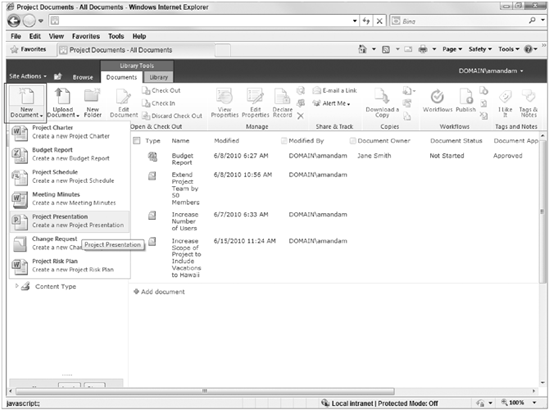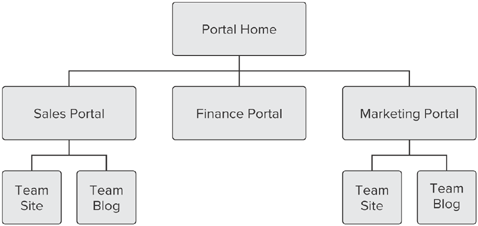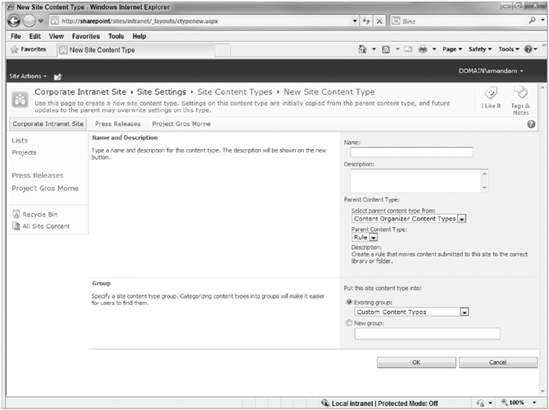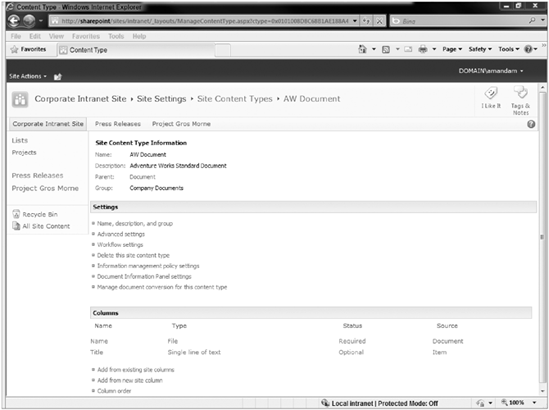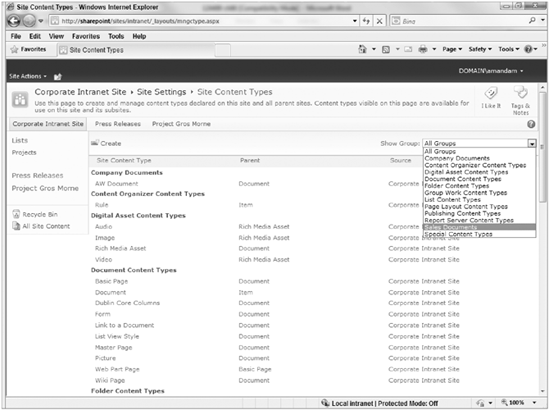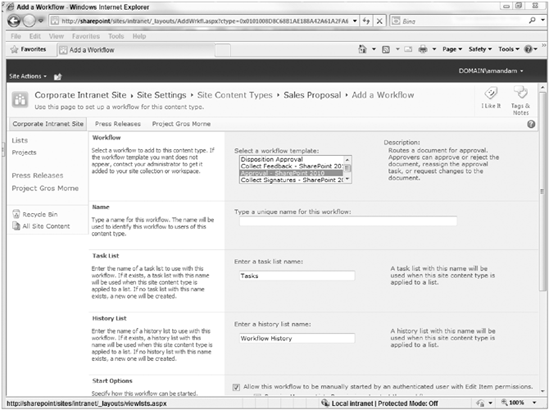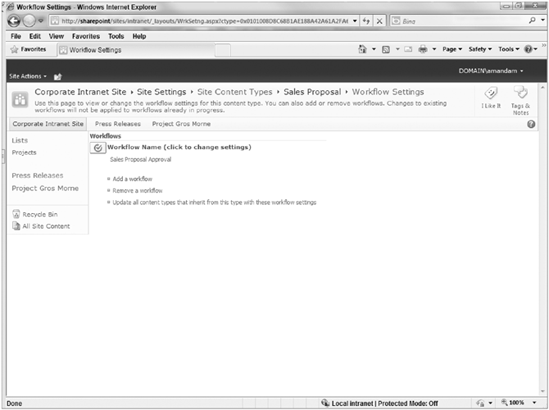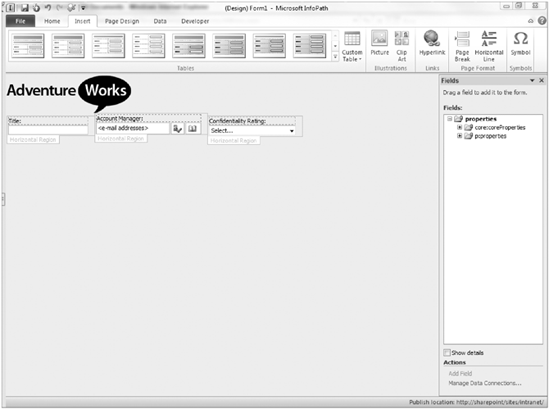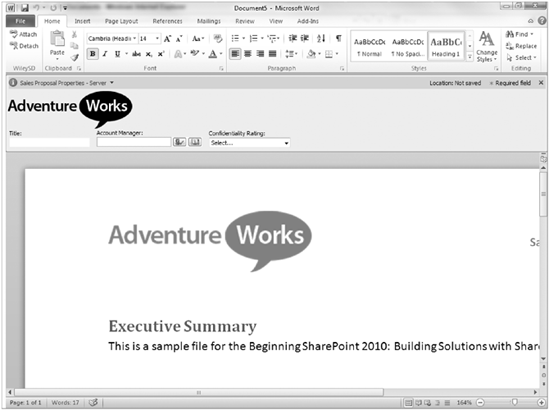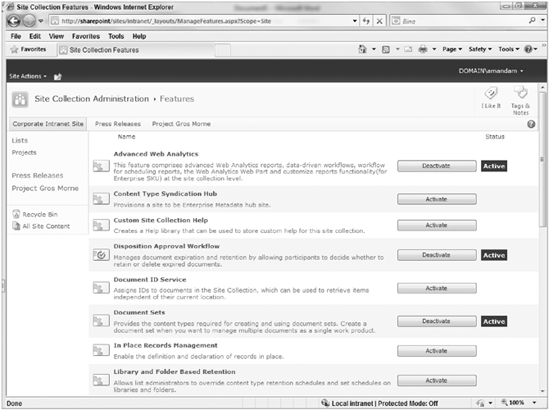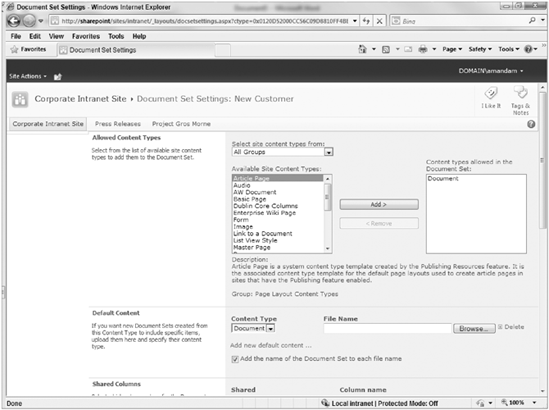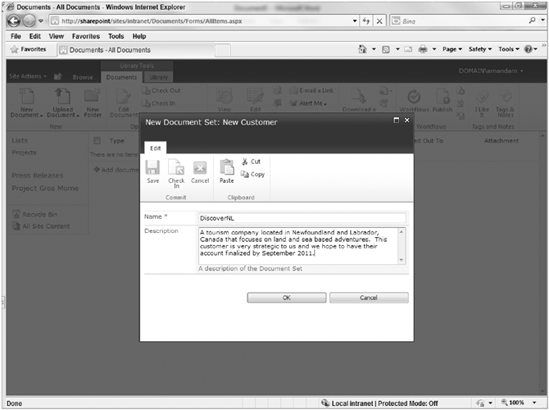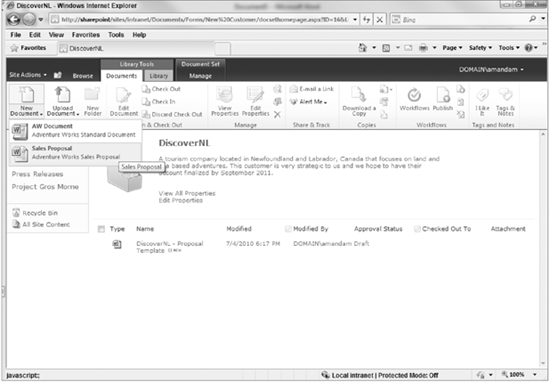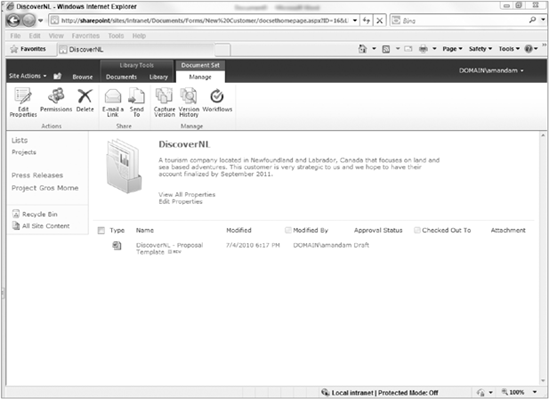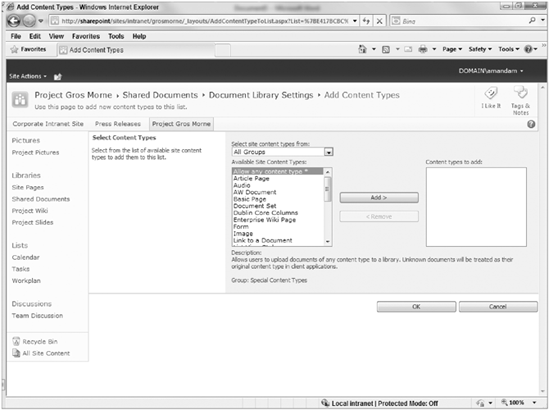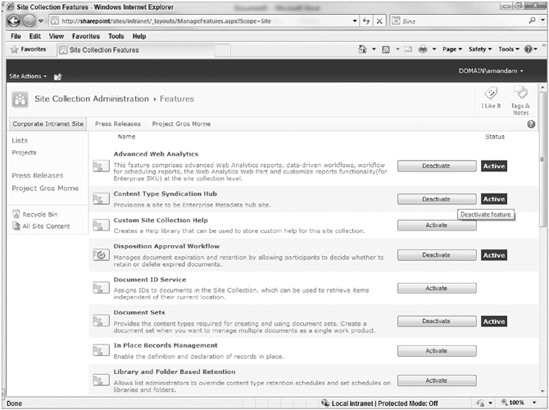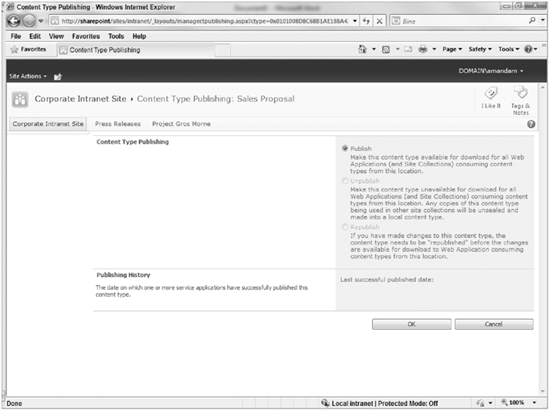WHAT YOU WILL LEARN IN THIS CHAPTER:
Thus far, this book has discussed components that can help you organize information in a SharePoint site. You should now know how to create lists and libraries, and assign metadata values to content items. You should also know how to associate business processes with lists and libraries so that you can track, review, and approve items in a consistent and automatic manner. Using this functionality in your work environment means that you spend more time doing actual work, rather than trying to locate information in disorganized filing systems.
This chapter takes the concepts discussed thus far and brings them together to create an information management package that ties to your content. After reading this chapter, you should feel comfortable creating content types suitable for efficiently managing the information that is vital to your organization.
A content type represents a group of informational items in your organization that share common properties such as meeting minutes. You can define these properties, which include name, description, and a grouping category, to meet your business needs. In addition, you can adjust the properties associated with templates, workflow, site columns, and information policies as well as the settings for the document information panel. You can change these properties at any time and optionally apply those changes to your entire environment.
Note
For more on the various Content properties and what they do, see the section "The Anatomy of a Content Type."
SharePoint offers several content types that provide solid foundations for all future content types. You can select one of these content types, and use it to create your content type in the central gallery, where you can then apply it to multiple lists and libraries throughout a site collection. By creating new content types, you can apply rules and properties to customize information and tie it to your business activities. Once you define your content type, you can create a new item by selecting the appropriate template from a drop-down menu presented by the New Document command on your list or library's Ribbon (see Figure 6-1). This chapter discusses the various elements of a content type as well as some of the configuration and customization alternatives of the most common content types.
When you create a content type, you must select a parent from which it will automatically inherit any existing settings for a template, workflow, or metadata columns. You should consider the content types you need for your organization and then identify any relations they may have with each other or inheritances that they share so that you can place similar content types into groups. Using the same parent for each of these content types means you can filter based on the parent and include information from all child content types. For example, to manage your workflow, you may need a general purchase request form that will manage the approval process for new purchases within each division. You can create a standard purchase request content type and then create each divisional content type using it as the template. All metadata and the form template will become associated with each divisional content type automatically; however, you can define a unique workflow process for each child content type to allow different departmental managers to approve requests. You can easily update the form; because each divisional content type is based on the same parent, edits to the parent are copied down into each child.
The magic of SharePoint is making its various pieces fit your business situation, and nowhere is that more evident than in content types. Content types all have properties, the basic ones being the name, description, and grouping category. In addition, you have properties associated with templates, workflow, site columns, and policy management as well as settings for the document information panel. You can define and redefine these properties to fit your business situations, but to do that, you need an understanding of the how to work with them. For example, you can change a content type's name to reflect a change in process, but it's important for you to make the name consistent and intuitive when you redefine it. In this section, you learn about the various content type properties and how to work with them.
Because the name is displayed on all the buttons and labels associated with the content, you should assign a clear and descriptive name. For example, users should intuitively know what name to select when they click the button for creating a new item in a document library. You should consider who will work with this content type and make sure that they understand exactly what they are creating when they select a name. This is especially critical when you work with the automated workflows, templates, and policies. For example, if your company sells multiple product lines related to aerospace and transportation, and you create a content type that contains the proposal template, approval process, and metadata related to a specific marine product line, consider using a name that clearly defines which product line it is associated with. Naming it "sales document" or "marine product documents" would not be as appropriate as "marine sales proposal."
As with all other SharePoint content elements, a good description helps communicate the purpose and intended use of a content type. If you concisely state what the content type is, users can more easily fill in information, modify settings, or select a content type for inclusion with a list or library.
You must define hierarchical relationships between two content types. In SharePoint, the parent content type defines the properties for a child content type, which, in turn, inherits all the parent's properties. For example, going back to the marine sales proposals scenario, you can create a new content type called "Marine Documents," which has specific site columns and metadata that you want to apply to all marine-related documents. By basing all Marine Sales Proposals on the Marine Document content type, they will inherit the existing properties of the parent—in this case, Marine Sales Proposals. Likewise, if you later need to add a new site column to all marine content types, you simply add columns to the Marine Documents parent content type to automatically have them added to the children of the content type. Once you create a content type, you cannot change its parent. Therefore, it is strongly recommended that you plan your content types carefully and work out the logistics of the hierarchy on paper before starting to define your content types in SharePoint.
You can organize your various customized content types by grouping them. As you create or edit a content type, you must specify a group name either by selecting an existing group name or by creating a custom group. Instituting some standards for groups provides a solid base for expanding and organizing content types as you create them. For example, using the Marine Sales Proposals as an example, it may be appropriate to associate the content type with a custom group called "Marine Sales Documents" that can store all content types related to the marine product line.
In many organizations, standard templates are used for business documents. Content types can be associated with these templates to improve the functionality and information flow within SharePoint and to make document libraries, for example, more useful to you. When you associate document templates with a content type, you can better control the quality of the data that you collect. You can base the template on a variety of file formats, including Word documents, Excel spreadsheets, InfoPath forms, and custom web pages. You can either upload a custom template to the content type, or you can point to a template stored at another location. If you want to point to an existing template, be sure that all members using the content type can access the location of the template. For example, if you create a sales proposal content type and a document template for sales proposals already exists on the sales team site, make sure that the people who will create content based on your newly created content type have access to that sales team site.
For Microsoft Office files, such as Word and Excel, updating or changing the document template associated with a content type has no effect on items that users have already created and that are stored in the document library. This is because of the way these files relate to a template. In Word, a document template is primarily only relevant for the initial creation of the document. However, for content types based on InfoPath or publishing templates such as page layouts, changing the template associated with the content type updates the existing documents to display the information as detailed in the template. This will become clearer when you explore those content types in greater detail later in this book.
Chapter 4 discussed how you can associate custom document templates with a document library. This association means that users can automatically generate documents based on that template by clicking the New Item button for a document library. With content types, you now have more than one item in the New Item menu, which gives you a single document repository in which to store several different types of information and simplify how people access materials.
To show you how to create and specify some of the reviewed properties of content types, this section presents two Try It Outs. In the first, you see how to create a new content type, and in the second, you see how to edit one of the content types that SharePoint has to offer to suit your needs by specifying a template.
Creating important documents often requires the creator to follow an equally important business process. This process ensures that everyone involved in the collaboration activity is doing their part and communicating properly. When people follow processes without the aid of automated tool, they often encounter or create roadblocks because of distractions and other duties. For example, if a sales manager completes an important sales proposal and sends it to a colleague or supervisor for feedback with an email notification, that colleague may not immediately respond because of another task or emergency and, as a result, the request gets buried in an inbox or lost in the shuffle. This is a common situation because many people struggle to keep up with email and daily responsibilities. Unfortunately, this means missed deadlines, frustration between team members, and missed opportunities, and it may ultimately impact the overall operations of the company.
By assigning a workflow template with a content type, you can define a realistic series of tasks with built-in reminders for a specific business activity so that workers can focus on their duties. For example, in the previous scenario, whenever a salesperson creates a sales proposal, he or she can send it to the sales team or a supervisor for feedback with tasks and deadlines automatically created so that the request for feedback is less likely to be lost. Even if the sales team supervisor does forget the task, the system will send reminder messages to the supervisor until the task is complete. This means that the salesperson doesn't have to follow up on the task.
Depending on the parent content type you select when you define your custom content type, you may already have workflows enabled. If these workflow processes do not apply, you can remove them, but be careful not to remove a workflow that is important to the operations of a specific content type. By updating the workflow settings of a parent, you can optionally update any content types that are inheriting from that content type.
Adding a custom workflow to a content type is a fairly simple process and similar to adding a workflow to a document library or list as described in Chapter 5. The advantage here, however, is that you typically only have to define the process once, and it is then applied to multiple document libraries that utilize that content type. If you add multiple content types to a single library, each content type can have its own unique workflow or set of processes that are independent of the others.
In Chapter 4, you learned about the importance of site columns when creating standard metadata properties for lists and libraries. To recap, site columns are stored in a central gallery on each site, and any list or library can use them on the same site or any site below it. Site columns provide standardization and ease of use when you want to share important information across multiple lists, libraries, or sites.
Site columns are also very important in content types. Because content types are created and stored in a central gallery, all associated components must be centralized as well. Therefore, you can only associate site columns with a content type. When you add a content type to a library, the required site columns are automatically associated with that library for use by the content type. You can create custom views on the columns and web parts, such as the content query web part, and you can apply advanced filtering.
Note
Web parts are explained in Chapter 7.
Remember the following when working with site columns:
When defining metadata for a content type, you can use existing site columns or create new site columns directly from the Content Type Settings page. When you use existing site columns, you are redirected to a site column selection page.
By using the Group Selection drop-down, you can filter the list of site columns to a more manageable size. This is why group names are very important, and why you should make them intuitive when you create site columns.
Once you select the site columns you want, you click the Add button to move them from the left-hand listbox to the right-hand listbox.
You can remove an item you may have added accidentally by selecting it from the box on the right and clicking the Remove button.
You can update all content types that inherit from the current content type with the new columns you selected. For example, if you have a content type called Human Resources Document that is the parent to the other content types Policies and Procedures and Vacation Request Form, and you select the Yes option in the Update List and Site Content Types section for a site column called Division that is added to the Human Resources Document, it will also be added to Policies and Procedures and Vacation Request Form content types.
You can also create a new site column as you create a content type. Even though you're creating the site column from the administration interface of the specific content type, SharePoint still adds it to the central gallery of the site, making it available to other content types, lists, and libraries on the current site and sites below it.
Whenever you are saving a file in a Microsoft application such a Word or Excel, you will notice a form appear at the top of the application containing all the columns that are associated with the content type or library you are saving to. This is the document information panel, which asks you to complete metadata, as shown in Figure 6-9, and which is the subject of the next Try It Out.
If you desire, you may modify the document information panel for a content type. We will review the process for doing this in the following Try It Out.
Another great feature of content types is how you can define certain policies and behaviors around how they are managed. Because content of a specific type quite often has the same requirements for retention and management, it is beneficial to define a set of policies around a content type and have those inherited by all documents that are created from it. While it is possible to define information management policies on a library, it is often a better practice to define the policy based on the content type so that you can have specific rules for each type of content that can be reused throughout your organization in a consistent manner.
You can configure the items in relation to a content type's information policies as listed in the following table:
We will review information management policies in detail in Chapter 14 when we look at the records management features of SharePoint.
If the document conversion feature is enabled on your web server, you can configure rules for each content type that support the files being automatically converted to an alternate file type such as a web page or image file. This feature will be reviewed as part of Chapter 13 when we review the web content management features of SharePoint.
SharePoint offers a repertoire of content types that address basic business needs. These are organized into groups according to their purpose. This section details each of these built-in content groups and types.
SharePoint offers powerful features that organize, track, and display data from a variety of sources so that you can monitor the status of your business. This section discusses the business intelligence content types, and Chapter 16 describes the useful set of business reporting tools included in this latest version of SharePoint. The content types in the following table are available as part of the Business Intelligence group. The indicator types contain columns that collect business intelligence information from a data source so that it can be presented as a key performance indicator (KPI) or in a report. By creating a new content type based on one of these base content types, you can augment the information that is gathered by default. You can also customize the dashboard and report types to meet your needs.
CONTENT TYPE | PARENT | DESCRIPTION |
|---|---|---|
Common Indicator Columns | A key performance indicator based on information stored within an Excel workbook. This type of indicator can be created from the Status list template. | |
Common Indicator Columns | A key performance indicator based on information entered manually into a list item. This type of indicator can be created from the Status list template. | |
Report | Document | An Excel document page for the browser-based display of spreadsheet information. |
Common Indicator Columns | A key performance indicator based on information stored within a SharePoint list. This type of indicator can be created from the Status list template. | |
Common Indicator Columns | A key performance indicator based on information stored within SQL Server Analysis Services. This type of indicator can be created from the Status list template. | |
Document | A preconfigured web part page with an associated Status List. This page can be further configured to provide an informative dashboard page to business stakeholders. |
Only one content type exists within the Content Organizer group, and it is tied primarily to the records management capabilities of SharePoint; however, it can be utilized in collaborative scenarios as well. We will explore this content type in Chapter 14.
You will probably use the document types frequently in your SharePoint sites because the typical site functions as a document repository and viewing system for your team. The following document types are built into SharePoint, many of which will be explored throughout this book.
CONTENT TYPE | PARENT | DESCRIPTION |
|---|---|---|
Document | Standard web page containing location for sharing text-based information. | |
Document | Item | Standard base content type for the storage of documents in SharePoint. |
Document | Based on the Document content type but contains many standard columns to conform to the requirements for the popular classification system known as Dublin Core. | |
Form | Document | Based on the Document content type and is specifically designed to support the use of InfoPath. See Chapter 12 for more information on this content type. |
Document | In some cases, a document may be stored in one location and linked from another library. This content type helps support such scenarios by creating a record or row in a document library that references the document located in the other location. | |
Document | System content type for the definition of list view styles. | |
Document | Content type for the definition of master pages. See Chapter 9 for more information on this content type. | |
Picture | Document | Based on the document content type and is the primary content type associated with a picture library. |
Web Part Page | Basic Page | A web page with a number of web part zones for the use of web parts. These web pages can come in a variety of layouts and templates. |
Wiki Page | Document | A web page for use within a wiki library. |
Only one content type exists within the Document Set group. The Document Set content type is a specialized content type that supports the management of a group of documents.
CONTENT TYPE | PARENT | DESCRIPTION |
|---|---|---|
Document Set | Document Collection Folder | Specialized content type for the grouping and management of related files as a single entity. |
When defining a document set, you associated one or more content types that can be created within the set as well as define specific templates or content that can exist within the document set folder when it is created. In the next two Try It Outs, you will enable the use of Document Set content types on your site collection and then define a Document Set for managing the sign-up process for new customers.
You use this type of content type for folders and discussion boards in SharePoint. Because individual discussions in SharePoint are stored within folders, it is appropriate that the base content type be affiliated with the Folder Content Types group. The following base content types are what SharePoint has to offer as part of the Folder Content Types group.
CONTENT TYPE | PARENT | DESCRIPTION |
|---|---|---|
Folder | Item | Specialized folder that supports columns and metadata like any other element stored within a list or library. |
Discussion | Folder | This content type is associated with a discussion list, which was discussed in Chapter 2. |
Summary Task | Folder | This content type is associated with the tasks and project tasks lists, which were discussed in Chapter 2. |
The Group Work content types are a set of specialized content types associated with lists available within the Group Work Site template. This site template is designed to be a collaborative location for sharing data between team members of subjects such as whereabouts, phone calls, assignments, and schedules. The content types associated with this group all inherit from the Item content type and are as follows:
Circulation
Holiday
New Word
Official Notice
Phone Call Memo
Resource
Resource Groups
Timecard
Users
What's New Notification
An important SharePoint feature is the capability to easily create and store information in lists. Lists can hold any type of information, from a simple To-Do list, to a more complex resource-tracking list. The following base content types are what SharePoint has to offer as part of the List Content Types group.
PARENT | DESCRIPTION | |
|---|---|---|
Announcement | Item | Based on the Item content type and used for tracking simple news updates for a team. This content type is associated with an announcements list, which was covered in Chapter 2. |
Comment | Item | Based on an Item content type and contains the columns required to post responses to blog articles. Blogs will be covered in Chapter 8. |
Contact | Item | Based on an Item content type and contains the columns required to share contact information. This content type is associated with the contacts list, which was covered in Chapter 2. |
East Asia Contact | Item | Very similar to the Contact content type but contains special columns related to phonetic information. We do not cover this content type in this book. |
Event | Item | Based on the Item content type and used for tracking date-based information such as appointments, meetings and events. This content type is associated with a calendar list, which was covered in Chapter 2. |
Issue | Item | Contains columns for tracking problems that may arise within a collaborative or work environment. This content type is associated with the issues list, which was covered in Chapter 2. |
Item | System | A parent content type of the Document content type and many list items. It is created by default with a single column for Title. |
Link | Item | Based on the Item content type and used for hyperlink references to sites or documents. This content type is associated with a links list, which was covered in Chapter 2. |
Item | Based on the Item content type and is used for storing replies associated with Discussion Topics. This content type is associated with a discussion board list, which was covered in Chapter 2. | |
Post | Item | Based on an Item content type and contains the columns required to post articles within a blog. Blogs will be covered in Chapter 8. |
Event | This content type contains information related to the group calendar list. | |
Schedule | Event | This content type contains information related to the group calendar list. |
Schedule and Reservations | Event | This content type contains information related to the group calendar list. |
Task | Item | Based on an Item content type and contains the columns required to share task information. This content type is associated with the tasks list, which was covered in Chapter 2. |
One of the most significant advancements of SharePoint over the past few versions has been its advancement as a web content management system. This great functionality allows users to create content for a site directly from the browser without having any special web development knowledge or skills.
Most sites have unique types of pages. For example, you might have a main page, a generic subpage, and a newsletter page. Each of these page types, in turn, has specific content elements that make it unique to the site. For example, the Newsletter page likely has a Title, Newsletter Body, and Published Date. A Page Layout content type defines these unique content elements by attaching site columns to your content type. You can later use this content type to create a Page Layout, which is a special type of template page that users can use to create new pages in a site. The following base content types are what SharePoint has to offer as part of the Page Layout Content Types group.
CONTENT TYPE | PARENT | DESCRIPTION |
|---|---|---|
Page | Contains many of the common properties that a page should have, including elements used for publishing such as scheduling date and others that are used for content display such as page content. | |
Enterprise Wiki Page | Page | Enterprise Wiki Page is the default content type for the Enterprise Wiki site template. It provides a basic content area as well as ratings and categories. |
Enterprise Wiki Page | Project Page is a content type included with the Enterprise Wiki site template. It provides some basic information to describe a project, including a project status and a contact name. | |
Page | Redirect Page is a content type associated with a specialized page template that supports the definition of a URL that will redirect visitors automatically to the described location. | |
Page | Contains a number of columns for the displaying and publishing of content. |
The PerformancePoint content types are utilized by the business intelligence features of SharePoint Server 2010. They will be discussed in detail in Chapter 16. These content types are used for the display of reporting information such as Dashboards, key performance indicators, and Reports. The PerformancePoint content types include the following:
PerformancePoint Dashboard
PerformancePoint Data Source
PerformancePoint Filter
PerformancePoint Indicator
PerformancePoint KPI
PerformancePoint Report
PerformancePoint Scorecard
Another web content management-related content type group in SharePoint Server is Publishing content types. The base publishing content types provide the structure for all major web publishing components. The following base content types are available as part of the Publishing content types group.
An important aspect of managing a SharePoint site or environment is to understand how to combine and manage the information that a team or group shares. In this section, you discover some of the common management tasks that ensure that users in your organization can easily share and use your content types.
In order for content types to be used within a SharePoint document library, the library must first be configured to utilize content types. We will review this process in the next Try It Out. While we will review the steps for enabling content types on a document library, the same steps apply to configuring a list to utilize content types.
Today's business world often requires working with various types of content, which means managing many document templates, business processes, and information policies. Using the standard configuration of a document library, you can only associate a single document template with a document library, so you would require a large number of document libraries just to accommodate unique document templates and classification requirements. By associating multiple content types with a document library (shown in the next Try It Out), however, you can freely manage all important information from a single location. These can be different types of templates using the same format, or completely different applications such as Microsoft Office Excel, InfoPath, PowerPoint, or Word. This means that you can save a tremendous amount of time because you can edit and share multiple types of documents from the same location.
Once you have defined your content types for a single site collection, you may wish to make them available to other site collections. To do this, you must first enable your site collection to be an Enterprise Metadata hub site. This is done by managing the Site Collection Features settings of your site. We will review this process in the next Try It Out.
This chapter discussed the very important SharePoint 2007 feature known as content types. Content types allow you to package and manage elements such as templates, workflow processes, policies, and metadata columns as a single reusable component. You can then associate these components with list and libraries throughout a site collection. Users can then make edits centrally to the site content type gallery, and all existing content types can be updated with the changes. After reading this chapter, you should know the following:
The default groups of content types include: Business Intelligence, Document, Folder, List, Page Layout, Publishing, and Special content types.
Every new content type must have a parent content type from which it inherits its settings. You can extend the parent content type to suit your business requirements.
You can associate a content type with a custom template, workflow processes, and site columns. You can also create information management policies to control what information is displayed when an item is opened or printed. In addition, you can configure rules to determine when it must expire.
Some content types are very basic in nature and do not require configuration; however, other content types may be more heavily regulated and controlled.
A single document library or list can host multiple content types. This allows users to work from a single repository for related content. However, when managing multiple content types and large amounts of data within a single library, consider using custom views to maintain an acceptable level of usability for users. Information should always be well organized and easy to find.

